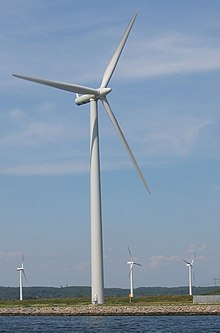
Back تعويض الكربون Arabic Compensació de carboni Catalan Uhlíková kompenzace Czech Klimakompensation German Αντιστάθμιση άνθρακα Greek Compensación de carbono Spanish آفست کربن Persian Päästökompensaatio Finnish Compensation carbone French קיזוז פחמן HE

Carbon offsetting is a carbon trading mechanism that enables entities such as governments or businesses to compensate for (i.e. “offset”) their greenhouse gas emissions by investing in projects that reduce, avoid, or remove emissions elsewhere.[2][3][4] When an entity invests in a carbon offsetting program, it receives carbon credits. These "tokens" are then used to account for net climate benefits from one entity to another.[5] A carbon credit or offset credit can be bought or sold after certification by a government or independent certification body.[6][7][8] One carbon offset or credit represents a reduction, avoidance or removal of one metric Tonne of carbon dioxide or its carbon dioxide-equivalent (CO2e).
Offset projects that take place in the future can be considered to be a type of promissory note. The purchaser of the offset credit pays carbon market rates for the credits. In turn they receive a promise that the purchaser's greenhouse emissions generated in the present (e.g. a ten-hour international flight) will be offset by elimination of an equal amount at some point in the future (e.g. 10 to 20 years for planting 55 seedlings). Offsets that were generated in the past are legitimate only if they were in addition to reductions that would have happened anyway.[9]
A variety of greenhouse gas reduction projects can create offsets and credits. These include forestry projects (avoidance of logging, sapling planting, etc.),[1][10] renewable energy projects (wind farms, biomass energy, biogas digesters, hydroelectric dams, etc.), as well as energy efficiency projects. Further projects include carbon dioxide removal projects, carbon capture and storage projects, and the elimination of methane emissions in various settings such as landfills.
Carbon offset and credit programs provide a mechanism for countries to meet their Nationally Determined Contributions (NDC) commitments to achieve the goals of the Paris Agreement.[11] Article 6 of the Paris Agreement includes three mechanisms for “voluntary cooperation” between countries towards climate goals, including carbon markets. Article 6.2 enabled countries to directly trade carbon credits and other units such as gigawatts (GW) of renewable power with each other. Article 6.4 established a new international carbon market allowing countries or companies to use carbon credits generated in other countries to help meet their climate targets.
Carbon offset and credit programs are coming under increased scrutiny because their claimed emissions reductions may be inflated compared to the actual reductions achieved.[12][13][14] To be credible, the reduction in emissions must meet three criteria. Firstly, they must last indefinitely (e.g. the newly planted forest must not be logged or susceptible to wildfires). Secondly, they must be additional to emission reductions that were going to happen anyway. And thirdly, they must be measured and monitored to assure the that the amount of reduction promised has in fact been attained.[9]
- ^ a b Hamrick, Kelley; Gallant, Melissa (May 2017). "Unlocking Potential: State of the Voluntary Carbon Markets 2017" (PDF). Forest Trends’ Ecosystem Marketplace. p. 10. Archived (PDF) from the original on 2020-08-14. Retrieved 2019-01-29.
- ^ Goodward, Jenna; Kelly, Alexia (August 2010). "Bottom Line on Offsets". World Resources Institute. Archived from the original on 2019-01-17. Retrieved 2010-09-08.
- ^ "Carbon offset". Collins English Dictionary - Complete & Unabridged 11th Edition. Retrieved September 21, 2012 from CollinsDictionary.com. Archived from the original on October 4, 2018. Retrieved September 24, 2012.
- ^ "What are Offsets?". Carbon Offset Research & Education. Archived from the original on 2019-11-21. Retrieved 2018-10-23.
- ^ Courtnell, Jane (2023-02-01). "Carbon Offsets vs Carbon Credits: What's the Difference?". Green Business Bureau. Retrieved 2023-12-07.
- ^ What is a Voluntary Carbon Market Credit? (PDF) (Report). S&P Global Commodity Insights. 2021. Retrieved May 4, 2023.
- ^ Fredman, Alex; Phillips, Todd (October 7, 2022). The CFTC Should Raise Standards and Mitigate Fraud in the Carbon Offsets Market (Report). Center for American Progress. Retrieved May 4, 2023.
- ^ "Emissions Trading – UNFCCC". United Nations. Retrieved May 4, 2023.
- ^ a b Hawken, Paul, ed. (2021). Regeneration: ending the climate crisis in one generation. New York: Penguin Books. ISBN 978-0-14-313697-2.
- ^ Haya, Barbara K.; Evans, Samuel; Brown, Letty; Bukoski, Jacob; Butsic, Van; Cabiyo, Bodie; Jacobson, Rory; Kerr, Amber; Potts, Matthew; Sanchez, Daniel L. (2023-03-21). "Comprehensive review of carbon quantification by improved forest management offset protocols". Frontiers in Forests and Global Change. 6. Bibcode:2023FrFGC...6.8879H. doi:10.3389/ffgc.2023.958879. ISSN 2624-893X.
- ^ "Climate Explainer: Article 6". World Bank. Retrieved 2023-03-29.
- ^ "Goldman School of Public Policy | Goldman School of Public Policy | University of California, Berkeley". gspp.berkeley.edu. Retrieved 2023-12-28.
- ^ Probst, Benedict; Toetzke, Malte; Anadon, Laura Diaz; Kontoleon, Andreas; Hoffmann, Volker (2023-07-27). Systematic review of the actual emissions reductions of carbon offset projects across all major sectors (Report). In Review. doi:10.21203/rs.3.rs-3149652/v1. hdl:20.500.11850/620307.
- ^ Cite error: The named reference
:1was invoked but never defined (see the help page).
© MMXXIII Rich X Search. We shall prevail. All rights reserved. Rich X Search